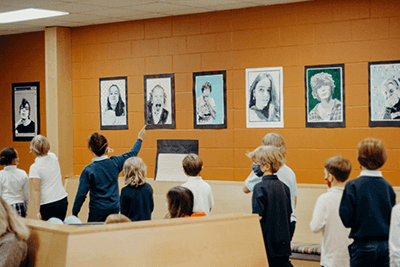February 17, 2022
 from Dr. Bill Hudson, Head of School
from Dr. Bill Hudson, Head of School
I am thrilled to see parents in the halls of MPA once more—we’ve missed you! With Omicron infections on a downward trend and our high vaccination rates, we have been able to open the school once again for parents. On my way back to my office after morning door duty on Monday, I happened upon three parents who had been enjoying time walking through the halls. In particular, they mentioned to me how impressed they were with the beautiful art our students have created that is on display throughout the building. Hardly a day goes by that I don’t stop to admire and enjoy it as it is one of the things I love most about MPA.
I was recently reading through the open-ended responses from the parent satisfaction survey administered in December and one comment caught my attention. In it, a parent questioned the requirement of art and theater in Middle School. I certainly respect the perspective of parents and realize that every child will not always enjoy the arts. I also know the importance of the arts in our mission and the long-lasting impact it has on students. An incredible amount of research has been conducted over the last decade on how music positively affects the brain and cognitive development.
For instance, one study found, “Involvement in the arts is associated with gains in math, reading, cognitive ability, critical thinking, and verbal skill. Arts education can also improve motivation, concentration, confidence, and teamwork.” Another study by a 15-year literature review done by the NEA found, “A growing body of evidence suggests that at virtually every stage of life, the arts can foster openness to novelty, encourage connections to people, places, things, and concepts, and promote the ability to take multiple perspectives, among other positive outcomes.”
On Wednesday, I wandered into a third grade art classroom and observed very engaged students paying rapt attention to their teacher as she introduced symmetry and walked them through the steps for their project for the day. Within five minutes I witnessed the impact of art —students were engaged in conceptual learning, practicing executive functioning skills, and critical thinking. One student struggled with translating what she observed to creating her own project. In that one moment, her failure presented her an opportunity learn how to overcome a mistake, reframe a challenge, channel her frustration, problem-solve, master the skill, and move on to the next. The look of accomplishment and sense of confidence on her face said everything about the research.
A 2005 report by the Rand Corporation about the visual arts argues that the intrinsic pleasures and stimulation of the art experience do more than enhance an individual’s life—according to the report, they “can connect people more deeply to the world and open them to new ways of seeing,” creating the foundation to forge social bonds and community cohesion.” It is through the arts that we grapple with what it means to be human. Whether through theater, music, or visual arts, students discover deeper forms of beauty and meaning.
When art is integrated with other subjects, such as the fourth grade social studies unit on hominids, research tells us how learning “sticks” so much more. The cave paintings done with natural tools such as pinecones, makes connections with societal, historical, and cultural contexts. Through imagination, students engage with new concepts and discover connection between ideas.
I’m overjoyed that parents have the same opportunity to now see what I see every day as I round a corner and happen upon a display of student art. I marvel in the wisdom and courage of our founders who built MPA on a principle that placed equal emphasis on the arts, academics, and athletics. Although they did not have access to the brain research that we do now, they knew the impact of the arts on the academic, social, emotional, and mental health of our students as well as their success in college and in life.
I recommend you take an MPA art crawl in our building and take in the joyfulness of the fifth grade watercolors, the skillfulness of Upper School block printmaking, the beauty of seventh grade pottery, first grade Renaissance period art, and so much more. You won’t be disappointed!